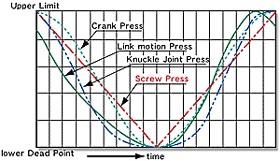Feature of the Screw Press
Feature of the Screw Press
There are following features of general products for forging except special purposes

Slide Movement Curve in Mechanical Press
-
1
The machine generated stamping pressure with screw mechanism instead of using eccentric mechanism like crank or link. Normally, stamping machine can be categorized into two types; mechanical press and hydraulic press. The screw press attributes to the former.
-
2No lower-dead-point exists and it is not necessary to worry about overload generated from variance of material oversize or heating temperature also slide sticking (slide stop due to overload sticking). In addition, the same material is able to be pressurized any number of times for bit-by-bit deforming to perform incremental forging. Upsetting of axis type is easily done without any transferring device.In case of machine with lower-dead-point is necessary to consider the variation of forged material thickness due to expansion of frame at pressing procedure. Namely, the position of the lower-dead-point of slide shifts to upward when the frame is expanded and the thickness of deformed product varies. Since screw press does not have the lower-dead-point, it is not necessary to worry about and has advantage especially at thin material forging.The screw press does not require the adjustment of lower-dead-point which saves time for preparation and has advantage for the production of multiple kinds-with small quantity.It may be possible to forge passing items from the first one.
-
3All flywheel energy is consumed at one time pressing and gives large deformation energy on the product. Large load which exceeds the nominal capacity is always applied on frame, however, it is not the problem when repetitive processing with two times of load because the frame is designed for two times of nominal capacity.
-
4Forming speed is very quick at forging and is so adequate especially for hot or warm processing. The die contacting time becomes further short by the rebound of slide at processing which results the extension of die life.The figure illustrates crank characteristics curve (ram stroke line diagram) among ordinary crank press, knuckle joint press and screw press. You can aware that the screw press has very high slide speed at around the point of lower-dead-point (usually approx. 800 mm/sec) and very short duration time of die stamping onto material. Thus the machine can complete the operation immediately before heated material becoming cool. Crank press or knuckle joint press, however, sometimes requires water coolant for its long contacting time with tool and material resulted in extremely raising tool temperature. Among general hot forging, temperature of die does not increase if the die contacting time is short and die life becomes longer.
-
5The stamping pressure is generated inside the frame. This eliminates extreme vibration against ground and avails to inexpensive foundation work.
-
6Simple structure reduces number of components, and allows to low installation and maintenance costs as well as providing high productivity. There is no clutch mechanism in servomotor type. Brake device is for emergency use at power failure and there is no consumable part. It is quite a less maintenance.
-
7Press energy can be preset easily and properly. Stable stamping operation can be done consecutively at every press cycle. Especially servo type, there is no friction clutch which makes variation of forming energy, so forming energy is generated every time with exactly the same quantity to perform precise pressuring.
-
8Press energy is very high. If the equivalent stamping capability is requested in the crank mechanism press, 1.3 to 1.8 times more of nominal capacity is needed.
-
9Availability to install into complete automatic manufacturing line and still absolutely no skill is needed for manual operation.
-
10The servo driven machine saves 30 to 50% of electricity energy with respect to conventional friction driven machine.



















